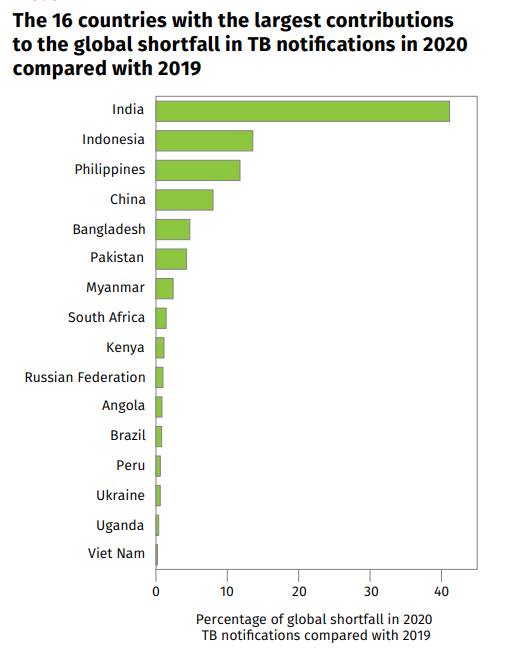Tuberculosis notification drops worldwide; India accounts for the largest dip: Global Tuberculosis Report 2021
With health services disrupted due to the COVID19 pandemic, a global shortfall in tuberculosis notifications has been reported. India has accounted for 41 per cent — the largest dip — in reporting TB between 2019 and 2020. Can the Indian government eliminate TB by 2025?


India shares the world’s highest burden of tuberculosis, a communicable disease. Photo: WHO
A World Health Organization (WHO) report shows that there has been a global drop in the number of new patients diagnosed with tuberculosis (TB) in 2020 as compared with 2019. And India accounts for the largest dip in this global shortfall in tuberculosis notifications.
The WHO report titled ‘Global Tuberculosis Report 2021’ released on October 14, shows that India accounted for 41 per cent of the total global drop of 1.3 million. This when the country shares the world’s highest burden of tuberculosis, a communicable disease.
The number of new patients diagnosed with TB globally dropped from 7.1 million in 2019 to 5.8 million in 2020.
After India, Indonesia reported the second highest drop of 14 per cent in notification of new TB patients, which was followed by the Philippines (12 per cent drop) and China (eight per cent drop).

The public health body held COVID19 pandemic responsible for the global shortfall in notification. “The COVID-19 pandemic has reversed years of progress in providing essential TB services and reducing TB disease burden,” reads the new report.
“This report confirms our fears that the disruption of essential health services due to the pandemic could start to unravel years of progress against tuberculosis,” Tedros Adhanom Ghebreyesus, WHO Director-General, was quoted as saying.
“I want to remind you that the struggle to end TB is not just a struggle against a single disease. It’s also the struggle to end poverty, inequity, unsafe housing, discrimination and stigma, and to extend social protection and universal health coverage,” he said adding that this is alarming news that must serve as a global wake-up call to close the gaps in diagnosis and treatment for the millions of people affected by the communicable disease.
Also Read: A disease that needs more attention than Coronavirus
The substantial reduction in TB case detection and reporting between 2019 and 2020 reflects both supply and demand-side disruptions to TB diagnostic and treatment services, said the WHO.
Disruptions, for instance, reduced health system capacity to continue to provide services, less willingness and ability to seek care in the context of lockdowns and associated restrictions on movement, concerns about the risks of going to health care facilities during a pandemic, and stigma associated with similarities in the symptoms related to TB and COVID-19.
A Gaon Connection report published earlier this year pointed out that with all eyes on the COVID-19 pandemic, accessing health care for tuberculosis in the country became a serious struggle in 2020, as frontline health workers, healthcare centres and resources were deployed on COVID-19 duty.
Can we end TB by 2025?
The Indian government launched the TB Free India campaign with the target of eliminating TB in the country by 2025, five years ahead of the global target of 2030.
Also Read: Budgam’s journey towards becoming India’s first TB-free district
It is estimated that the fight against TB faces a setback of five to eight years, globally, due to disruptions to health services, and delays in diagnosis and treatment caused by COVID-19.
“We will need a lot of patch up work to be done to bring our healthcare system to be fully functional for TB care,” Sanjeev Nair, associate professor, department of pulmonary medicine, Government Medical College, Trivandrum, Kerala, had told Gaon Connection.
“The government would need more time to achieve its target to end TB by 2025,” he had added.
The disease that is spread when people who are sick with TB expel bacteria into the air (by coughing), typically affects the lungs (pulmonary TB) but can affect other sites.
However, the disease can be prevented and is curable. According to WHO, about 85 per cent of people who develop TB disease can be successfully treated with a six-month drug regimen and regimens of 1–6 months can be used to treat TB infection.

